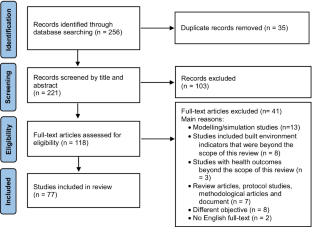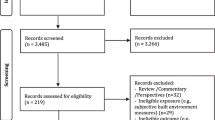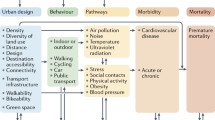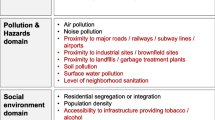Abstract
In the current century, non-communicable diseases (NCDs), particularly cardiovascular diseases, diabetes, cancer, and chronic respiratory diseases, are the most important cause of mortality all over the world. Given the effect of the built environment on people’s health, the present study seeks to conduct a systematic review in order to investigate the relationship between urban form and these four major NCDs as well as their main risk factors. Two independent reviewers in November 2020 after an extensive search through PubMed and Scopus identified 77 studies. Studies published in English were included if they addressed one or more attributes of urban form in relation to any major NCDs and their main risk factors. Publication date, country, geographical scale, study design, methods of built environment measurement, and findings of the relationships among variables were extracted from eligible studies. The findings suggest that the elements of urban form (density, transportation and accessibility, characteristics of building and streetscape, land use, spatial layouts and configuration) could increase or inhibit these diseases through their effect on physical activity, diet, air pollution, blood pressure, and obesity. However, there are study shortages, contradictions, and ambiguities in these relationships which are mainly due to methodological and conceptual challenges. As a result, more in-depth research is needed to achieve solid and consistent results that could be made into clear guidelines for planning and designing healthier cities.


Similar content being viewed by others
References
Lopez RP. The built environment and public health. 1st ed. John Wiley & Sons; 2012.
Prüss-Üstün A, Wolf J, Corvalán C, Bos R, Neira M. Preventing disease through healthy environments: a global assessment of the burden of disease from environmental risks. World Health Organization; 2016. https://apps.who.int/iris/handle/10665/204585. Accessed 14 Oct 2020.
World Health Organization. Noncommunicable diseases country profiles 2018. World Health Organization. 2018. https://apps.who.int/iris/handle/10665/274512. Accessed 13 June 2021.
World Health Organization. Global action plan for the prevention and control of noncommunicable diseases 2013–2020. World Health Organization; 2013. https://apps.who.int/iris/rest/bitstreams/442296/retrieve. Accessed 14 Oct 2020.
World Health Organization. Noncommunicable diseases and air pollution: WHO European high-level conference on noncommunicable diseases. World Health Organization. 2019. https://www.euro.who.int/__data/assets/pdf_file/0005/397787/Air-Pollution-and-NCDs.pdf. Accessed 13 June 2021.
World Health Organization. Noncommunicable diseases: progress monitor 2020. World Health Organization. 2020. https://apps.who.int/iris/rest/bitstreams/1267930/retrieve. Accessed 19 Oct 2020.
Giles-Corti B, Vernez-Moudon A, Reis R, et al. City planning and population health: a global challenge. Lancet. 2016;388(10062):2912–24. https://doi.org/10.1016/S0140-6736(16)30066-6.
Northridge ME, Sclar ED, Biswas P. Sorting out the connections between the built environment and health: a conceptual framework for navigating pathways and planning healthy cities. J Urban Health. 2003;80(4):556–68. https://doi.org/10.1093/jurban/jtg064.
Vlahov D, Freudenberg N, Proietti F, et al. Urban as a determinant of health. J Urban Health. 2007;84(1):16–26. https://doi.org/10.1007/s11524-007-9169-3.
Northridge ME, Freeman L. Urban planning and health equity. J Urban Health. 2011;88(3):582–97. https://doi.org/10.1007/s11524-011-9558-5.
World Health Organization. Health as the pulse of the new urban agenda: United Nations conference on housing and sustainable urban development, Quito, October 2016. 2016. https://apps.who.int/iris/rest/bitstreams/1061550/retrieve. Accessed 6 Mar 2021.
Dempsey N, Brown C, Raman S, et al. Elements of urban form. In: Jenks M, Jones C, editors. Dimensions of the sustainable city. Future City, vol 2. Springer, Dordrecht; 2010. p. 21–51. https://doi.org/10.1007/978-1-4020-8647-2_2.
Živković J. Urban form and function. Clim Action. 2020:862–871. https://doi.org/10.1007/978-3-319-95885-9_78.
Chandrabose M, Rachele JN, Gunn L, et al. Built environment and cardio-metabolic health: systematic review and meta-analysis of longitudinal studies. Obes Rev. 2019;20(1):41–54. https://doi.org/10.1111/obr.12759.
Dendup T, Feng X, Clingan S, Astell-Burt T. Environmental risk factors for developing type 2 diabetes mellitus: a systematic review. Int J Environ Res Public Health. 2018;15(1):78. https://doi.org/10.3390/ijerph15010078.
Malambo P, Kengne AP, De Villiers A, Lambert EV, Puoane T. Built environment, selected risk factors and major cardiovascular disease outcomes: a systematic review. PLoS ONE. 2016;11(11):e0166846. https://doi.org/10.1371/journal.pone.0166846.
Wray AJD, Minaker LM. Is cancer prevention influenced by the built environment? A multidisciplinary scoping review. Cancer. 2019;125(19):3299–311. https://doi.org/10.1002/cncr.32376.
McCormack GR, Shiell A. In search of causality: a systematic review of the relationship between the built environment and physical activity among adults. Int J Behav Nutr Phys Act. 2011;8(1):1–11. https://doi.org/10.1186/1479-5868-8-125.
Kärmeniemi M, Lankila T, Ikäheimo T, Koivumaa-Honkanen H, Korpelainen R. The built environment as a determinant of physical activity: a systematic review of longitudinal studies and natural experiments. Ann Behav Med. 2018;52(3):239–51. https://doi.org/10.1093/abm/kax043.
Durand CP, Andalib M, Dunton GF, Wolch J, Pentz MA. A systematic review of built environment factors related to physical activity and obesity risk: implications for smart growth urban planning. Obes Rev. 2011;12(5):e173–82. https://doi.org/10.1111/j.1467-789X.2010.00826.x.
Schulz M, Romppel M, Grande G. Built environment and health: a systematic review of studies in Germany. J Public Health. 2018;40(1):8–15. https://doi.org/10.1093/pubmed/fdw141.
Kim DH, Yoo S. How does the built environment in compact metropolitan cities affect health? A systematic review of Korean studies. Int J Environ Res Public Health. 2019;16(16):2921. https://doi.org/10.3390/ijerph16162921.
McCormack GR, Cabaj J, Orpana H, et al. Evidence synthesis A scoping review on the relations between urban form and health: a focus on Canadian quantitative evidence. Health Promot Chronic Dis Prev Can. 2019;39(5):187. https://doi.org/10.24095/hpcdp.39.5.03.
Page MJ, McKenzie JE, Bossuyt PM, The PRISMA, et al. statement: an updated guideline for reporting systematic reviews. BMJ. 2020;2021:372. https://doi.org/10.1016/j.ijsu.2021.105906.
Stockton JC, Duke-Williams O, Stamatakis E, Mindell JS, Brunner EJ, Shelton NJ. Development of a novel walkability index for London, United Kingdom: cross-sectional application to the Whitehall II Study. BMC Public Health. 2016;16:416. https://doi.org/10.1186/s12866-020-01731-9.
Timperio A, Crawford D, Ball K, Salmon J. Typologies of neighbourhood environments and children’s physical activity, sedentary time and television viewing. Health Place. 2017;43:121–7. https://doi.org/10.1016/j.healthplace.2016.10.004.
Ewing R, Brownson RC, Berrigan D. Relationship between urban sprawl and weight of United States youth. Am J Prev Med. 2006;31(6):464–74. https://doi.org/10.1016/j.amepre.2006.08.020.
McCormack GR, Friedenreich CM, Giles-Corti B, Doyle-Baker PK, Shiell A. Do motivation-related cognitions explain the relationship between perceptions of urban form and neighborhood walking? J Phys Act Health. 2013;10(7):961–73. https://doi.org/10.1123/jpah.10.7.961.
King AC, Toobert D, Ahn D, et al. Perceived environments as physical activity correlates and moderators of intervention in five studies. Article. Am J Health Promot. 2006;21(1):24–35. https://doi.org/10.4278/0890-1171-21.1.24.
McCormack GR, Shiell A, Doyle-Baker PK, Friedenreich CM, Sandalack BA. Subpopulation differences in the association between neighborhood urban form and neighborhood-based physical activity. Health Place. 2014;28:109–15. https://doi.org/10.1016/j.healthplace.2014.04.001.
Siu VW, Lambert WE, Fu R, Hillier TA, Bosworth M, Michael YL. Built environment and its influences on walking among older women: use of standardized geographic units to define urban forms. J Environ Public Health. 2012;2012:203141. https://doi.org/10.1155/2012/203141.
de Sa E, Ardern CI. Associations between the built environment, total, recreational, and transit-related physical activity. BMC Public Health. 2014;14:693. https://doi.org/10.1186/1471-2458-14-693.
Rundle AG, Sheehan DM, Quinn JW, et al. Using GPS data to study neighborhood walkability and physical activity. Am J Prev Med. 2016;50(3):e65–72. https://doi.org/10.1016/j.amepre.2015.07.033.
Rundle A, Diez Roux AV, Free LM, Miller D, Neckerman KM, Weiss CC. The urban built environment and obesity in New York City: a multilevel analysis. Am J Health Promot. 2007;21(4 Suppl):326–334. https://doi.org/10.4278/0890-1171-21.4s.326.
Koohsari MJ, Kaczynski AT, Hanibuchi T, et al. Physical activity environment and Japanese adults’ body mass index. Article. Int J Environ Res Public Health. 2018;15(4)596. https://doi.org/10.3390/ijerph15040596.
Ewing R, Schmid T, Killingsworth R, Zlot A, Raudenbush S. Relationship between urban sprawl and physical activity, obesity, and morbidity. Am J Health Promot. 2003;18(1):47–57. https://doi.org/10.4278/0890-1171-18.1.47.
Shoultz G, Givens J, Drane JW. Urban form, heart disease, and geography: a case study in composite index formation and bayesian spatial modeling. Article. Popul Res Policy Rev. 2007;26(5–6):661–85. https://doi.org/10.1007/s11113-007-9049-2.
Réquia Júnior WJ, Roig HL, Koutrakis P. A novel land use approach for assessment of human health: the relationship between urban structure types and cardiorespiratory disease risk. Article. Environ Int. 2015;85:334–42. https://doi.org/10.1016/j.envint.2015.09.026.
Sturm R, Cohen DA. Suburban sprawl and physical and mental health. Article. Public Health. 2004;118(7):488–96. https://doi.org/10.1016/j.puhe.2004.02.007.
Clark LP, Millet DB, Marshall JD. Air quality and urban form in U.S. urban areas: evidence from regulatory monitors. Article. Environ Sci Technol. 2011;45(16):7028–7035. https://doi.org/10.1021/es2006786.
Monteiro A, Carvalho V, Velho S, Sousa C. Assessing and monitoring urban resilience using COPD in Porto. Article. Sci Total Environ. 2012;414:113–9. https://doi.org/10.1016/j.scitotenv.2011.11.009.
Li C, Song Y, Tian L, Ouyang W. Urban form, air quality, and cardiorespiratory mortality: a path analysis. Article. Int J Environ Res Public Health. 2020;17(4)1202. https://doi.org/10.3390/ijerph17041202.
Polsky JY, Moineddin R, Glazier RH, Dunn JR, Booth GL. Foodscapes of southern Ontario: neighbourhood deprivation and access to healthy and unhealthy food retail. Can J Public Health = Revue canadienne de sante publique. 2014;105(5):e369–75. https://doi.org/10.17269/cjph.105.4541.
Murphy M, Badland H, Jordan H, Koohsari MJ, Giles-Corti B. Local food environments, suburban development, and BMI: a mixed methods study. Int J Environ Res Public Health. 2018;15(7). https://doi.org/10.3390/ijerph15071392.
Hankey S, Marshall JD, Brauer M. Health impacts of the built environment: within-urban variability in physical inactivity, air pollution, and ischemic heart disease mortality. Article. Environ Health Perspect. 2012;120(2):247–53. https://doi.org/10.1289/ehp.1103806.
Fan C, Tian L, Zhou L, et al. Examining the impacts of urban form on air pollutant emissions: evidence from China. Article. J Environ Manag. 2018;212:405–14. https://doi.org/10.1016/j.jenvman.2018.02.001.
He L, Liu Y, He P, Zhou H. Relationship between air pollution and urban forms: evidence from prefecture-level cities of the yangtze river Basin. Article. Int J Environ Res Public Health. 2019;16(18)3459. https://doi.org/10.3390/ijerph16183459.
Li C, Wang Z, Li B, Peng ZR, Fu Q. Investigating the relationship between air pollution variation and urban form. Article. Build Environ. 2019;147:559–68. https://doi.org/10.1016/j.buildenv.2018.06.038.
Bereitschaft B, Debbage K. Urban form, air pollution, and CO2 emissions in large U.S. metropolitan areas. Article. Prof Geogr. 2013;65(4):612–635. https://doi.org/10.1080/00330124.2013.799991.
Cerin E, Frank LD, Sallis JF, et al. From neighborhood design and food options to residents’ weight status. Appetite. 2011;56(3):693–703. https://doi.org/10.1016/j.appet.2011.02.006.
McCormack GR. Neighbourhood built environment characteristics associated with different types of physical activity in Canadian adults. Article. Health Promot Chronic Dis Prev Can. 2017;37(6):175–185. https://doi.org/10.24095/hpcdp.37.6.01.
Collins PA, Tait J, Fein A, Dunn JR. Residential moves, neighbourhood walkability, and physical activity: a longitudinal pilot study in Ontario Canada. BMC Public Health. 2018;18(1):933. https://doi.org/10.1186/s12889-018-5858-y.
Wei YD, Xiao W, Medina R, Tian G. Effects of neighborhood environment, safety, and urban amenities on origins and destinations of walking behavior. Article. Urban Geogr. 2019. https://doi.org/10.1080/02723638.2019.1699731.
Lee JS. Urban form, children’s active travel to/from school, and travel related physical activity. Article. Int Rev Spat Plann Sustain Dev. 2020;8(1):21–38. https://doi.org/10.14246/IRSPSD.8.1_21.
McCormack GR, Shiell A, Giles-Corti B, et al. The association between sidewalk length and walking for different purposes in established neighborhoods. Article. Int J Behav Nutr Phys Act. 2012;992. https://doi.org/10.1186/1479-5868-9-92.
Cutumisu N, Spence JC. Sport fields as potential catalysts for physical activity in the neighbourhood. Article. Int J Environ Res Public Health. 2012;9(1):294–314. https://doi.org/10.3390/ijerph9010294.
Patterson PK, Chapman NJ. Urban form and older residents’ service use, walking, driving, quality of life, and neighborhood satisfaction. Am J Health Promot. 2004;19(1):45–52. https://doi.org/10.4278/0890-1171-19.1.45.
McCormack GR, McLaren L, Salvo G, Blackstaffe A. Changes in objectively-determined walkability and physical activity in adults: a quasi-longitudinal residential relocation study. Int J Environ Res Public Health. 2017;14(5). https://doi.org/10.3390/ijerph14050551.
Rundle AG, Chen Y, Quinn JW, et al. Development of a neighborhood walkability index for studying neighborhood physical activity contexts in communities across the U.S. over the past three decades. J Urban Health. 2019;96(4):583–590. https://doi.org/10.1007/s11524-019-00370-4.
Frank LD, Andresen MA, Schmid TL. Obesity relationships with community design, physical activity, and time spent in cars. Am J Prev Med. 2004;27(2):87–96. https://doi.org/10.1016/j.amepre.2004.04.011.
Fathi S, Sajadzadeh H, Sheshkal FM, et al. The role of urban morphology design on enhancing physical activity and public health. Article. Int J Environ Res Public Health. 2020;17(7)2359. https://doi.org/10.3390/ijerph17072359.
Shen YS, Lung SC. Multiple impacts and pathways of urban form and environmental factors on cardiovascular mortality. Sci Total Environ. 2020;738:139512. https://doi.org/10.1016/j.scitotenv.2020.139512.
Kerr J, Frank L, Sallis JF, Saelens B, Glanz K, Chapman J. Predictors of trips to food destinations. Article. Int J Behav Nutr Phys Act. 2012;958. https://doi.org/10.1186/1479-5868-9-58.
Luan Q, Jiang W, Liu S, Guo H. Impact of urban 3D morphology on particulate matter 2.5 (PM2.5) concentrations: case study of Beijing, China. Article. Chin Geogr Sci. 2020;30(2):294–308. https://doi.org/10.1007/s11769-020-1112-5.
Özbil A, Yeşiltepe D, Argın G. Home and school environmental correlates of childhood BMI. Article. J Transp Health. 2020;16100823. https://doi.org/10.1016/j.jth.2020.100823.
Charreire H, Weber C, Chaix B, et al. Identifying built environmental patterns using cluster analysis and GIS: relationships with walking, cycling and body mass index in French adults. Article. Int J Behav Nutr Phys Act. 2012;959. https://doi.org/10.1186/1479-5868-9-59.
Ahn Y, Park J, Bruckner TA, Choi S. Do local employment centers modify the association between neighborhood urban form and individual obesity? Article. Environ Plann A. 2018;50(5):1128–43. https://doi.org/10.1177/0308518X18765478.
Richardson EA, Mitchell R, Hartig T, de Vries S, Astell-Burt T, Frumkin H. Green cities and health: a question of scale? J Epidemiol Community Health. 2012;66(2):160–5. https://doi.org/10.1136/jech.2011.137240.
McCormack GR, Mardinger C. Neighbourhood urban form and individual-level correlates of leisure-based screen time in Canadian adults. BMJ Open. 2015;5(11):e009418. https://doi.org/10.1136/bmjopen-2015-009418.
Koohsari MJ, Shibata A, Ishii K, et al. Built environment correlates of objectively-measured sedentary behaviours in densely-populated areas. Article. Health Place. 2020;66102447. https://doi.org/10.1016/j.healthplace.2020.102447.
Gao Y, Wang Z, Liu C, Peng ZR. Assessing neighborhood air pollution exposure and its relationship with the urban form. Article. Build Environ. 2019;155:15–24. https://doi.org/10.1016/j.buildenv.2018.12.044.
McMillan TE. The relative influence of urban form on a child’s travel mode to school. Article. Transp Res Part A: Policy Pract. 2007;41(1):69–79. https://doi.org/10.1016/j.tra.2006.05.011.
Jack E, McCormack GR. The associations between objectively-determined and self-reported urban form characteristics and neighborhood-based walking in adults. Int J Behav Nutr Phys Act. 2014;11:71. https://doi.org/10.1186/1479-5868-11-71.
Lovasi GS, Bader MD, Quinn J, Neckerman K, Weiss C, Rundle A. Body mass index, safety hazards, and neighborhood attractiveness. Am J Prev Med. 2012;43(4):378–84. https://doi.org/10.1016/j.amepre.2012.06.018.
Berrigan D, Troiano RP. The association between urban form and physical activity in U.S. adults. Am J Prev Med. 2002;23(2 Suppl):74–9. https://doi.org/10.1016/s0749-3797(02)00476-2.
King WC, Belle SH, Brach JS, Simkin-Silverman LR, Soska T, Kriska AM. Objective measures of neighborhood environment and physical activity in older women. Am J Prev Med. 2005;28(5):461–9. https://doi.org/10.1016/j.amepre.2005.02.001.
Beenackers MA, Kamphuis CB, Prins RG, Mackenbach JP, Burdorf A, van Lenthe FJ. Urban form and psychosocial factors: do they interact for leisure-time walking? Med Sci Sports Exerc. 2014;46(2):293–301. https://doi.org/10.1249/mss.0000000000000017.
Drewnowski A, Moudon AV, Jiao J, Aggarwal A, Charreire H, Chaix B. Food environment and socioeconomic status influence obesity rates in Seattle and in Paris. Int J Obes (2005). 2014;38(2):306–14. https://doi.org/10.1038/ijo.2013.97.
Holt NL, Spence JC, Sehn ZL, Cutumisu N. Neighborhood and developmental differences in children’s perceptions of opportunities for play and physical activity. Article. Health Place. 2008;14(1):2–14. https://doi.org/10.1016/j.healthplace.2007.03.002.
Koohsari MJ, Sugiyama T, Lamb KE, Villanueva K, Owen N. Street connectivity and walking for transport: role of neighborhood destinations. Article. Prev Med. 2014;66:118–22. https://doi.org/10.1016/j.ypmed.2014.06.019.
Frank LD, Schmid TL, Sallis JF, Chapman J, Saelens BE. Linking objectively measured physical activity with objectively measured urban form: findings from SMARTRAQ. Am J Prev Med. 2005;28(2 Suppl 2):117–25. https://doi.org/10.1016/j.amepre.2004.11.001.
Kerr J, Norman G, Millstein R, et al. Neighborhood environment and physical activity among older women: findings from the San Diego cohort of the women’s health initiative. Article. J Phys Act Health. 2014;11(6):1070–1077. https://doi.org/10.1123/jpah.2012-0159.
Ribeiro AI, Hoffimann E. Development of a neighbourhood walkability index for porto metropolitan area. How strongly is walkability associated with walking for transport? Article. Int J Environ Res Public Health. 2018;15(12)2767. https://doi.org/10.3390/ijerph15122767.
Coogan PF, White LF, Evans SR, et al. Longitudinal assessment of urban form and weight gain in African-American women. Am J Prev Med. 2011;40(4):411–8. https://doi.org/10.1016/j.amepre.2010.12.013.
Su JG, Apte JS, Lipsitt J, et al. Populations potentially exposed to traffic-related air pollution in seven world cities. Article. Environ Int. 2015;78:82–9. https://doi.org/10.1016/j.envint.2014.12.007.
Daniel M, Kestens Y, Paquet C. Demographic and urban form correlates of healthful and unhealthful food availability in Montréal, Canada. Can J Public Health = Revue canadienne de sante publique. 2009;100(3):189–93. https://doi.org/10.1007/bf03405538.
Fecht D, Fortunato L, Morley D, Hansell AL, Gulliver J. Associations between urban metrics and mortality rates in England. Environ Health. 2016;15 Suppl 1(Suppl 1):34. https://doi.org/10.1186/s12940-016-0106-3.
Kaplan S, Nielsen TAS, Prato CG. Walking, cycling and the urban form: a Heckman selection model of active travel mode and distance by young adolescents. Article. Transp Res Part D: Transp Environ. 2016;44:55–65. https://doi.org/10.1016/j.trd.2016.02.011.
Li F, Fisher KJ, Brownson RC, Bosworth M. Multilevel modelling of built environment characteristics related to neighbourhood walking activity in older adults. J Epidemiol Community Health. 2005;59(7):558–64. https://doi.org/10.1136/jech.2004.028399.
Lee C. Impacts of urban form on air quality: emissions on the road and concentrations in the US metropolitan areas. Article. J Environ Manag. 2019;246:192–202. https://doi.org/10.1016/j.jenvman.2019.05.146.
Coogan PF, White LF, Adler TJ, Hathaway KM, Palmer JR, Rosenberg L. Prospective study of urban form and physical activity in the Black Women’s Health Study. Am J Epidemiol. 2009;170(9):1105–17. https://doi.org/10.1093/aje/kwp264.
Liang Z, Wei F, Wang Y, et al. The context-dependent effect of urban form on air pollution: a panel data analysis. Article. Remote Sens. 2020;12(11)1793. https://doi.org/10.3390/rs12111793.
She Q, Peng X, Xu Q, et al. Air quality and its response to satellite-derived urban form in the Yangtze River Delta, China. Article. Ecol Indic. 2017;75:297–306. https://doi.org/10.1016/j.ecolind.2016.12.045.
Liu Y, Wu J, Yu D. Disentangling the complex effects of socioeconomic, climatic, and urban form factors on air pollution: a case study of China. Article. Sustainability (Switzerland). 2018;10(3)776. https://doi.org/10.3390/su10030776.
Bechle MJ, Millet DB, Marshall JD. Effects of income and urban form on urban NO2: global evidence from satellites. Article. Environ Sci Technol. 2011;45(11):4914–9. https://doi.org/10.1021/es103866b.
Yang J, Shi B, Zheng Y, Shi Y, Xia G. Urban form and air pollution disperse: key indexes and mitigation strategies. Article. Sustain Cities Soc. 2020;57101955. https://doi.org/10.1016/j.scs.2019.101955.
Stone B Jr. Urban sprawl and air quality in large US cities. Article. J Environ Manag. 2008;86(4):688–98. https://doi.org/10.1016/j.jenvman.2006.12.034.
Mou Y, Song Y, Xu Q, He Q, Hu A. Influence of urban-growth pattern on air quality in China: a study of 338 cities. Article. Int J Environ Res Public Health. 2018;15(9)1805. https://doi.org/10.3390/ijerph15091805.
Zhou C, Li S, Wang S. Examining the impacts of urban form on air pollution in developing countries: a case study of China’s megacities. Article. Int J Environ Res Public Health. 2018;15(8)1565. https://doi.org/10.3390/ijerph15081565.
Liu Y, Wu J, Yu D, Ma Q. The relationship between urban form and air pollution depends on seasonality and city size. Article. Environ Sci Pollut Res. 2018;25(16):15554–67. https://doi.org/10.1007/s11356-018-1743-6.
Wineman JD, Marans RW, Schulz AJ, van der Westhuizen DL, Mentz GB, Max P. Designing healthy neighborhoods: contributions of the built environment to physical activity in Detroit. Article. J Plann Educ Res. 2014;34(2):180–189. https://doi.org/10.1177/0739456X14531829.
McCormack GR, Koohsari MJ, Turley L, et al. Evidence for urban design and public health policy and practice: space syntax metrics and neighborhood walking. Article. Health Place. 2019;102277. https://doi.org/10.1016/j.healthplace.2019.102277.
Smith M, Hosking J, Woodward A, et al. Systematic literature review of built environment effects on physical activity and active transport–an update and new findings on health equity. Int J Behav Nutr Phys Act. 2017;14(1):1–27. https://doi.org/10.1186/s12966-017-0613-9.
Roux AVD. Residential environments and cardiovascular risk. J Urban Health. 2003;80(4):569–89. https://doi.org/10.1093/jurban/jtg065.
Sun W, Bao P, Zhao X, Tang J, Wang L. Road traffic and urban form factors correlated with the incidence of lung cancer in high-density areas: an ecological study in Downtown Shanghai, China. J Urban Health. 2021:1–16. https://doi.org/10.1007/s11524-021-00529-y.
Acknowledgements
This article was extracted from a M.s thesis. The authors acknowledge the Department of Urban design and planning, Tarbiat Modares University for the support of the research.
Author information
Authors and Affiliations
Corresponding author
Additional information
Publisher's Note
Springer Nature remains neutral with regard to jurisdictional claims in published maps and institutional affiliations.
Supplementary Information
Below is the link to the electronic supplementary material.
Rights and permissions
About this article
Cite this article
Fazeli Dehkordi, Z.S., Khatami, S.M. & Ranjbar, E. The Associations Between Urban Form and Major Non-communicable Diseases: a Systematic Review. J Urban Health 99, 941–958 (2022). https://doi.org/10.1007/s11524-022-00652-4
Accepted:
Published:
Issue Date:
DOI: https://doi.org/10.1007/s11524-022-00652-4




